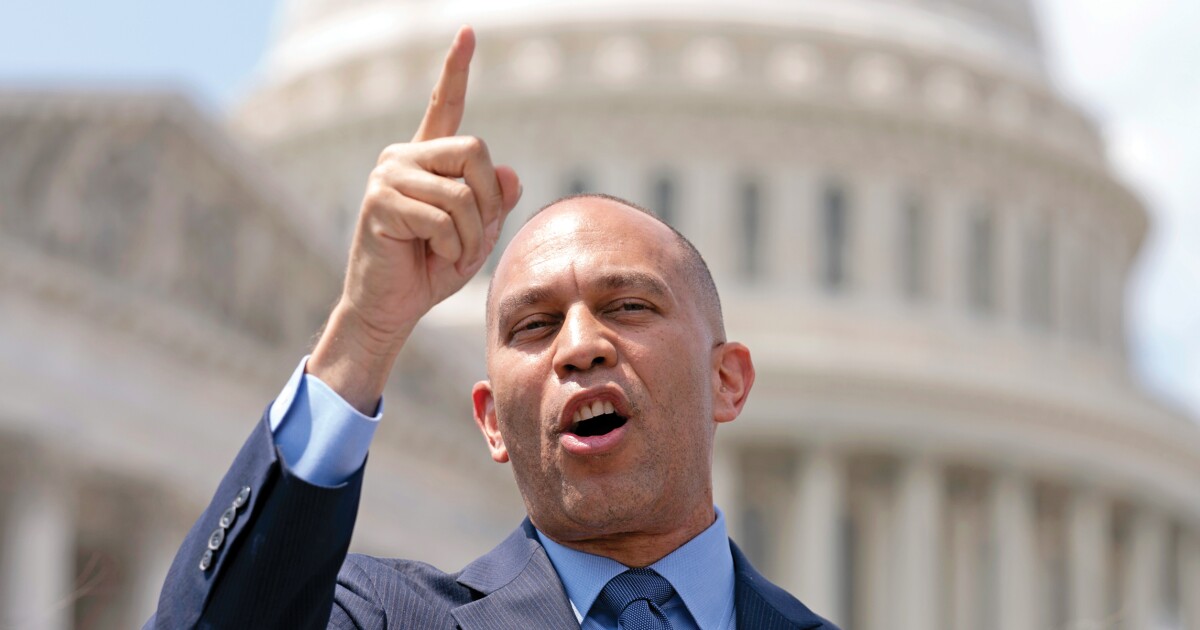

For the whole three-week duration of the speakerless House, Minority Leader Hakeem Jeffries (D-NY) sought to seduce his Republican colleagues with the siren song of bipartisanship.
“This is about what is good for the American people, not as Democrats or Republicans but as Americans,” Jeffries told PBS NewsHour in mid-October. “That’s why, at this moment, we have got to find a way to come together, restructure the House in a bipartisan way, designed to allow for commonsense things to come to the floor, receive an up-or-down vote, for us to be able to actually move legislation that emerges from the Senate that is bipartisan in nature.”
HOUSE ELECTS MIKE JOHNSON AS SPEAKER AFTER THREE WEEKS AT AN IMPASSE
Jeffries held up the working relationship between Senate Majority Leader Chuck Schumer (D-NY) and Senate Minority Leader Mitch McConnell (R-KY), in a 51-49 chamber where the minority has real power and most legislation requires 60 votes to pass, as the gold standard to which the House GOP should aspire.
“But this is an issue right now for the Republicans to work out. It is the responsibility of the Republican majority to identify a speaker who can both achieve 217 under the current number of people who are in the House or hold and maintain 217,” the House Democratic leader continued. “And over the last week or so, the Republican majority has been unable to do either.”
Never fear, Jeffries assured viewers. He stood ready to offer an olive branch that could turn into a lifeline for the recalcitrant Republicans. “And that’s why we continue to offer a bipartisan path forward, so we can restructure the rules of the House to enable commonsense, bipartisan legislation that has strong support from Democrats and Republicans to receive up-or-down votes without being blocked by the extreme MAGA Republican wing of the House Republican Conference,” he said. Jeffries said there was only one condition: “We just need traditional Republicans to break from their extremist wing and join us in a bipartisan coalition.”
If the repeated references to the “MAGA” wing of the GOP, a focus group-tested adjective perfected by White House adviser Anita Dunn to equate any Republican to the right of Sen. Susan Collins (R-ME) with former President Donald Trump — and perhaps not even she would get a pass in a competitive election — did not give away the game, Jeffries’s remarks before handing over the gavel to newly elected House Speaker Mike Johnson (R-LA) surely did.
“House Democrats will continue to push back against extremism in this chamber and throughout the country,” Jeffries said. “House Democrats will continue to protect Social Security, protect Medicare, protect Medicaid, protect our children, protect our climate, protect low-income families, protect working families, protect the middle class, protect organized labor, protect the LGBTQ community, protect our veterans, protect older Americans, protect the Affordable Care Act, protect the right to vote, protect the peaceful transfer of power, protect our democracy, and protect a woman’s freedom to make her own reproductive healthcare decisions.”
A few rhetorical flourishes about democracy aside, this essentially says that bipartisanship is possible if both parties come together to enact virtually the entire Democratic agenda. This is because, in Jeffries’s telling, the Democrats are a centrist party and the Republicans an extremist one.
Jeffries is not a centrist himself, even if he does not occupy the left-most space of his caucus. But President Joe Biden surely campaigned as one. It was critical to his securing the Democratic nomination, the notion that he was an electable, institutionalist, deal-making alternative to Sen. Bernie Sanders (I-VT). This was also how Biden won over the suburban voters he needed to flip the states Trump won in 2016 back into the Democratic column four years later.
To the extent that Biden has governed as a centrist, it has largely been due to the narrowness of Democratic congressional majorities. His vast spending programs, still sufficient to help stoke inflation to a 41-year high, either had to shrink or be abandoned in order to reach his desk.
Even on the policies where Biden has arguably restrained his party’s most progressive tendencies, he has not been able to stop the younger generation of Democrats from moving in the opposite direction. Biden has attempted to nudge his party away from destructive slogans such as “defund the police,” with his White House regularly releasing memos arguing that Republican budget priorities reveal they are the real police defunders. Major Democratic cities suffering from high crime continue to elect mayors who are at least defund adjacent, however. Democratic leaders like Schumer look nervously over their shoulders for any primary challenges by the likes of Rep. Alexandria Ocasio-Cortez (D-NY).
Biden has, for now, held the “Squad” at bay on the question of defending Israel during its war with Hamas. When the House passed a pro-Israel resolution in its first act since Republicans elected a new speaker, only nine Democrats voted against it while another six voted present. Polling before the grisly Oct. 7 Hamas attack on Israel suggested rank-and-file Democratic voters were becoming less sympathetic to the Israeli cause in recent years.
Reports that Biden had to toughen the language on White House statements about the Israel-Hamas war to avoid equivocation cut both ways. Yes, Biden deserves credit for making the revisions. But it suggests that the younger liberals who populate his staff are either more sympathetic to the Squad or unduly solicitous of their constituents’ votes.
This came into full public view at a White House briefing when press secretary Karine Jean-Pierre was asked about rising antisemitism, a concern about which Biden’s team has been fairly outspoken. “Muslims and those perceived to be Muslim have endured a disproportionate number of hate-fueled attacks,” she replied, later saying she misheard the question.
House Democrats have become monolithically liberal to the extent that was unthinkable during former Presidents Bill Clinton’s and Barack Obama’s administrations, much less the entirety of Biden’s Capitol Hill career. The Blue Dog Coalition holds just 10 seats in this Congress, down from 29 in 1994 and a peak of 64 in 2008, when Democrats last made a concerted effort to recruit centrist candidates in swing districts.
This meant of course that Democrats had large majorities but were only to pass a limited amount of liberal legislation due to electoral rebukes and centrist defections. Clinton was able to get his 1993 tax increase by just one vote in each chamber and the 1994 crime bill, with which Biden is associated. Republicans won control of both houses of Congress that November.
A similar dynamic played out when just enough centrist Democrats in both houses of Congress were allowed to walk the plank on Obamacare for it to pass. Republicans then promptly recaptured the House in 2010.
It is true that the 1994 and 2010 elections took a big chunk out of the Democratic centrists. The districts held by Democrats that contained the most conservative voters went Republican in both wave elections and some intervening years. Democratic years in 2006 and 2018 had a similar effect on centrist Republicans. But it is equally indisputable that there has been a failure of centrist nerve among Democrats as the center of gravity in the party has shifted inexorably leftward.
The Senate has been split 50-50 and then 51-49 Democratic during Biden’s time in the White House, increasing the bargaining power of the party’s last centrists. But neither Sens. Joe Manchin (D-WV) nor Sen. Kyrsten Sinema (I-AZ), who left the party but still caucuses with Senate Democrats, are as conservative as many Democrats in good standing as late as the Obama years.
Consider abortion, often said to illustrate that the Democrats are centrist and mainstream while Republicans are extremist and radical. In 2003, five Democratic senators voted against an amendment that expressed the sense of the Senate that Roe v. Wade was correctly decided. One of them was Harry Reid, then the second-ranking Democrat in the upper chamber who would become the party’s floor leader within the next four years.
Today the closest thing to an anti-abortion Democrat in the Senate is Manchin, who described himself as “deeply disappointed that the Supreme Court has voted to overturn Roe v. Wade.” While adding that he “will always consider” himself “pro-life,” he also now supports “legislation that would codify the rights Roe v. Wade previously protected.”
The legislation congressional Democrats actually advanced under the guise of codifying Roe went too far for Manchin. This left him the last Democratic senator to support any unambiguous statutory gestational limitations on abortion. That no longer includes Sen. Bob Casey (D-PA), son of the Democratic governor named in the Planned Parenthood v. Casey decision that came within one vote of overturning Roe 30 years earlier.
The younger Casey, after decades of presenting himself as a dissenter from his party’s liberal orthodoxy on abortion, denounced Roe’s reversal in a statement. “Our daughters and granddaughters should not grow up with fewer rights than their mothers,” he said. Casey backed the legislation that Manchin rejected. An NBC News story about Casey’s position change described him in the headline as an “anti-abortion Democrat.” It’s a path Biden, who in 1982 sponsored an anti-Roe constitutional amendment that would have sent abortion policy back to the states, traveled decades earlier.
Centrist Democrats were largely AWOL in the House speakership fight. Lost in Jeffries’s protestations about bipartisanship was the fact that every House Democrat voted with eight Republicans to remove a speaker who had cut a deal with them on both the debt ceiling and temporary funding of the government, realizing by their own admission that it could result in a speaker who would do neither of those things unless a rump of Republicans agreed to empower Democrats in a coalition government.
Self-styled centrist Rep. Jared Golden (D-ME) said in a statement as the motion to vacate was approaching that McCarthy was “not the leader I would choose — he doesn’t have the pulse of the people of Maine’s Second District. Absent any significantly meaningful benefit for Maine’s Second District, I see no reason to vote for him.” But all that would have been required was for a handful of such Democrats to vote present, reducing the threshold for McCarthy’s retention of the gavel.
“McCarthy got himself in this mess,” Rep. Brad Schneider (D-IL) of the centrist New Democrat Coalition told the Associated Press. “It’s up to McCarthy to get himself out.”
One of the few centrist Democrats to dangle support for a Republican speaker candidate under certain conditions was Rep. Dean Phillips (D-MN). He has been tossed from the Democratic leadership and is trying to mount a primary challenge against Biden, running slightly to the president’s right. Phillips still voted with all the other Democrats.
The speakership flap threatened to upend the Problem Solvers Caucus, one of the few bipartisan centrist initiatives in the House. “This was supposed to be a time when Problem Solvers were supposed to drop their partisanship and do what’s right for America,” Rep. Nick LaLota (R-NY) complained to the Wall Street Journal. “I’m tremendously disappointed that nobody, no Democrat Problem Solver, stepped up to do so, and I’m reassessing if I’ll remain a member of that caucus.”
McCarthy’s Republican coalition partners were undoubtedly unpalatable even to centrist Democrats. But after Democratic PACs pumped millions of dollars into ads helpful to so-called MAGA Republicans during the midterm elections, it seemed another example of the party preferring to campaign against GOP dysfunction rather than counteract it in a bipartisan fashion. Democrats’ purity about McCarthy didn’t stop them from collaborating with Rep. Matt Gaetz (R-FL).
The obvious Democratic rejoinder is that they are not to blame for the problems inside the Republican Party, which include erratic leadership and poor coalition-building. Yet these problems are frequently discussed and scrutinized, not least by conservatives who would like to see the GOP move in a different direction. The dwindling number of centrist Democrats, and the liberals who pretend to be among their ranks, all too often get a pass.
Discussing this phenomenon in no way excuses the failures of Republican leaders or the GOP’s own manifold problems.
The centrist-liberal two-step starts at the top of the Democratic Party. Before Biden and Jeffries, Obama made his political bones at a national level with a soaring speech about the futility of “slicing and dicing” the country into red and blue states. Obama instead mainstreamed the George McGovern coalition and extended the post-2000 period of intense political polarization.
CLICK HERE TO READ MORE FROM THE WASHINGTON EXAMINER
If Democrats as a whole are as reasonable and centrist as they claim, why can they at best fight the radical MAGA party to a near tie nationally? It took a runoff for Democrats to dispatch flawed GOP contender Herschel Walker in Georgia, securing their 51st Senate seat. Biden came within 43,000 votes in three states to an Electoral College loss to Trump in 2020 and trails the multi-indicted, post-Jan. 6 former president in several national and battleground state polls three years later.
Republicans’ infighting and excesses may cost them again in 2024. But it won’t last long if the Democrats’ center doesn’t hold.
W. James Antle III is the Washington Examiner’s politics editor.






